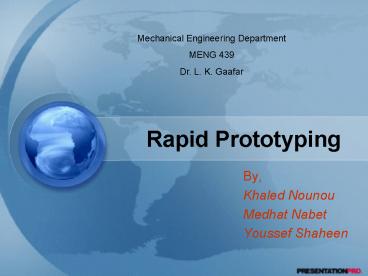Rapid Prototyping PowerPoint PPT Presentation
1 / 25
Title: Rapid Prototyping
1
Rapid Prototyping
Mechanical Engineering Department MENG 439 Dr. L.
K. Gaafar
- By,
- Khaled Nounou
- Medhat Nabet
- Youssef Shaheen
2
Outline
- Introduction
- Rapid Prototyping Technique
- Rapid Prototyping Processes
- SLS --- Selective Laser Sintering
- SLA --- StereoLithography
- LOM --- Laminated Object Manufacturing
- FDM --- Fused Deposition modeling
- Economic Evaluation
- Safety considerations
- Questions
3
Introduction
- Rapid Prototyping (RP) techniques are methods
that allow designers to produce physical
prototypes quickly. - It consists of various manufacturing processes by
which a solid physical model of part is made
directly from 3D CAD model data without any
special tooling. - The first commercial rapid proto typing process
was brought on the market in 1987. - Nowadays, more than 30 different processes (not
all commercialized) with high accuracy and a
large choice of materials exist. - These processes are classified in different ways
by materials used, by energy used, by lighting of
photopolymers, or by typical application range.
4
Rapid Prototyping Technique
- In the Rapid Prototyping process the 3D CAD data
is sliced into thin cross sectional planes by a
computer. - The cross sections are sent from the computer to
the rapid prototyping machine which build the
part layer by layer. - The first layer geometry is defined by the shape
of the first cross sectional plane generated by
the computer. - It is bonded to a starting base and additional
layers are bonded on the top of the first shaped
according to their respective cross sectional
planes. - This process is repeated until the prototype is
complete.
5
Rapid Prototyping Technique
- Process Flow
3D Solid modeling
Data preparation
Part Building
Pass
Reject
Redesign
6
Rapid Prototyping Technique
7
Rapid Prototyping Processes
- SLS --- Selective Laser Sintering
- SLA --- Stereolithography
- LOM --- Laminated Object Manufacturing
- FDM --- Fused Deposition Modeling
- Others
8
Rapid prototyping Processes
SLS SLA LOM FDM
- SLS
9
Rapid prototyping Processes
- Application Range
- Visual Representation models
- Functional and tough prototypes
- cast metal parts
10
Rapid prototyping Processes
- Advantages
- Flexibility of materials used
- PVC, Nylon, Sand for building sand casting cores,
metal and investment casting wax. - No need to create a structure to support the part
- Its parts do not require any post curing except
when ceramic is used. - Disadvantages
- During solidification, additional powder may be
hardened at the border line. - The roughness is most visible when parts contain
sloping (stepped) surfaces.
11
Rapid prototyping Processes
SLS SLA LOM FDM
- SLA
12
Rapid prototyping Processes
- Application Range
- Parts used for functional tests
- Manufacturing of medical models
- Form fit functions for assembly tests
13
Rapid prototyping Processes
- Advantages
- Possibility of manufacturing parts which are
impossible to be produced conventionally in a
single process - Can be fully atomized and no supervision is
required. - High Resolution
- No geometric limitations
- Disadvantages
- Necessity to have a support structure
- Require labor for post processing and cleaning
14
Rapid prototyping Processes
SLS SLA LOM FDM
- LOM (Laminated Object Manufacturing)
15
Rapid prototyping Processes
- Application Range
- Visual Representation models
- Large Bulky models as sand casting patterns
16
Rapid prototyping Processes
- Advantages
- Variety of organic and inorganic materials can be
used - Paper, plastic, ceramic, composite
- Process is faster than other processes
- No internal stress and undesirable deformations
- LOM can deal with discontinuities, where objects
are not closed completely - Disadvantages
- The stability of the object is bonded by the
strength of the glued layers. - Parts with thin walls in the z direction can not
be made using LOM - Hollow parts can not be built using LOM
17
Rapid prototyping Processes
SLS SLA LOM FDM
- FDM (Fused Deposition Modeling)
18
Rapid prototyping Processes
- FDM
19
Rapid prototyping Processes
- Application Range
- Conceptual modeling
- Fit, form applications and models for further
manufacturing procedures - Investment casting and injection molding
20
Rapid prototyping Processes
- Advantages
- Quick and cheap generation of models
- There is no worry of exposure to toxic chemicals,
lasers or a liquid chemical bath. - Disadvantages
- Restricted accuracy due to the shape of material
used, wire is 1.27 mm diameter.
21
Rapid prototyping Processes
- Other Processes
- Ballistic Particle Manufacturing (BPM)
- This process uses a 3D solid model data to direct
streams of material at a target. - 3D Printing
- It creates parts by layered printing process. The
layers is produced by adding a layer of powder to
the top of a piston and cylinder containing a
powder bed and the part is being fabricated. - Model Maker
- It uses ink jet printer technology with 2 heads.
One deposits building material, and the other
deposits supporting wax.
22
Rapid Prototyping Products
23
Economic Evaluation
- Requires special labor, methods and equipments.
- High equipment cost approximately 200 000.
- Fast production of physical prototypes with no
lead time required. - Early introduction of products to markets.
- Encourages and Facilitates product development.
- High operational expenses (laser replacement 10
000), (maintenance 15 000 per year). - More cost effective for sophisticated and complex
models. - The spread of this technology can dramatically
decrease the equipment cost.
24
Safety Considerations
- The door of the rapid prototyping machine should
be locked. - Special ventilation for the processes that emit
toxic gasses. - Wearing safety coat and gloves when using
processes that use toxic chemicals. - Avoid interference with laser beams, UV rays and
hot waxed parts.
25
References
- Kochan D., Solid Freeform Manufacturing 1993.
- Zhang G., Richardson M., Economic Evaluation of
Rapid Prototyping in the Development of new
Products. - http//ecoleing.uqtr.uquebec.ca/geniedoc/gmm/produ
ctique/rp_gener.htm - http//www.biba.uni-bremen.de/groups/rp/rp_intro.h
tml - http//www.cadcamnet.com/Default.htmRPReport

